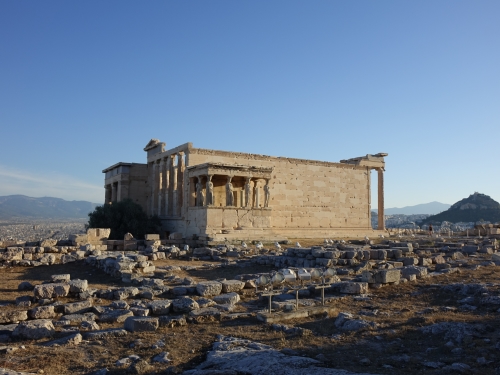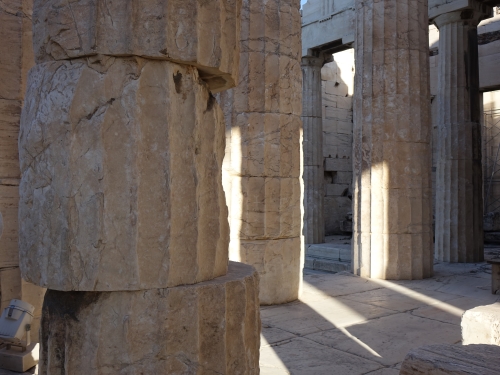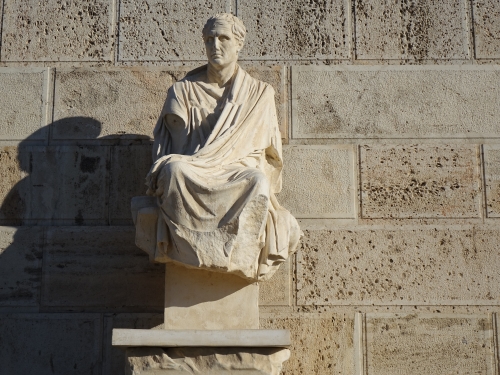Blog WHS Visits
Athens Acropolis revisited
In 2001, I visited the Athens Acropolis for the first time. I went on a Sunday morning. Entrance was free on that day of the week. I made no note of other visitors, only of being welcomed (or: slightly scared) by 2 stray dogs at the entrance gate. Last month I went back and witnessed what impact the surge in mass tourism has had: the entrance fee is now 20 EUR for this single site and you really have to coordinate your visit well to avoid queuing.

I arrived at the gate at 7.50 am, 10 minutes before opening. This awarded me with spot #5 in the queue for the ticket office, where 5 people in a row just were getting started doing their repetitive work all day. This is not a kind of job that in Greece is replaced by machines quickly – although you can buy e-tickets. At 8 am the queue had grown to some 40 people. Two dogs also came over to have a look, probably not the same individuals that I encountered 17 years ago!
I was one of the first persons at the site that day and on my way up I even met the party of soldiers that hoist the national flag there each day. The Parthenon is a massive structure, still with scaffolding covering most of its interior. This has been the case for a long time and will go on until 2020 at least. The effect is that you can only walk around it. The other monuments on the plateau are not accessible either (except from the Propylaea via which you enter): this does take something away from the visiting experience. Walking down via the South slopes you’ll pass more ruins with great historical value but which aren't the best remaining examples of their type that can be found in Greece. A fairly recent addition (re-placement) is one of the poet's statues that adorned the way to the Theater of Dionysus.

The New Acropolis Museum lies just outside the South Gate, near the Theatre of Dionysus. It is an impressive modern building, the entrance costs a reasonable 5 EUR. There is a strict ‘No photography’ policy here, which came as a surprise as I was able to freely take pictures of about every single object in the excellent National Archaeological Museum of Athens the day before.
The Museum has 3 sloping floors of exhibits. The lower ones I found ‘more of the same’ after having visited the National Archaeological Museum. At the top floor they have a reconstruction of the full Parthenon frieze: “From the entire frieze that survives today, 50 meters are in the Acropolis Museum, 80 meters in the British Museum, one block in the Louvre, whilst other fragments are scattered in the museums of Palermo, the Vatican, Würzburg, Vienna, Munich and Copenhagen”, according to the museum’s website. What I liked best however are the 5 original remaining Caryatid statues that have been saved from the Erechteion. The 6th is in the British Museum. The ones now present at the Erechteion on the Acropolis are replicas.

I am a bit in doubt whether I should adjust my rating for this WHS. As a visiting experience the Athens Acropolis is somewhat disappointing – I found so this time and that was what I remembered from my previous visit as well. There’s no doubt about its universal value of course. I had rated it 4 stars before (an ‘8 out of 10’ in my own conversion table), a lower score already than given by the average community member. Somehow it feels less ‘grand’ than the Ancient Egyptian temples at Luxor for example, where you can freely roam around and much more is left in situ.
Els - 17 October 2018
Comments
Els Slots 17 October 2018
If I remember well, there are large signs from the entrance gates on that photography is forbidden. But that may be geared only towards the first slope upwards, which is the Gallery of the Slopes - which per the website is excluded from the permission to photograph at all. Also, I saw a tourist being reprimanded taking a photo with his cell phone of one of the smaller objects in the glass boxes there (which hold similar objects as in the National Archaeological Museum, where photography is allowed).
So who knows, maybe photography is allowed at the large reconstructed Parthenon frieze at the top floor.
By the way, the official website also states: "Publication of photographs in print and electronic media is not allowed....)"
Solivagant 17 October 2018
"The New Acropolis Museum ............. There is a strict ‘No photography’ policy here"
We visited in Oct 2015 and faced the same apparent "rule". In fact it was being so widely ignored that we ignored it too (albeit not too "openly"!).
However I note that the Acropolis Museum Web site states the policy as being -
"Photography: Photography without flash is permitted in all museum exhibition areas, excluding the Gallery of the Slopes and the Archaic Gallery" See - https://whyathens.com/the-acropolis-museum/
Who knows, perhaps it depends on how they feel on the day?